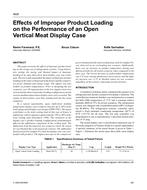Description
This paper presents the effects of improper product loading on the energy use of refrigeration systems. Using laboratory testing, the energy and thermal impact of improper loading of an open three-deck meat display case was evaluated. The test results quantified the impact of improper product loading on the total cooling load of the fixture and the compressor power demand and energy usage. The impact was also evident on product temperatures. Prior to designing the test scenarios, over 30 supermarkets in the Los Angeles area were visited and the observed product loading configurations inside various medium temperature display cases were recorded. The results of observations were then summarized into five main categories.
In a typical supermarket, open, multi-deck, medium temperature display cases could account for up to 50% of the total refrigerated display case lineups (EPRI 1992). The major contributor to the total cooling load of this type of fixture is infiltration, which comprises approximately 70% to 80% of the total cooling load (Faramarzi 1999). The variations in the display case’s product loading configurations predominately affected the infiltration component of the cooling load. The infiltration load decreased in test scenarios where the return air was blocked due to decreased air velocity. The infiltration load increased by roughly 8% when the display case was overloaded with products. The highest increase in the compressor power demand and the total cooling load, each by roughly 6%, was observed in an overloading test scenario. Additionally, there was an increase in product temperature during post defrost periods for all tested scenarios when compared to the base case. The lowest increase in peak product temperature was 1°F in air curtain interference test scenario, and the highest increase was 11°F in blocked return air test scenario, regardless of the system’s operating suction pressure.
Units: I-P
Citation: ASHRAE Transactions, vol. 109, pt. 1
Product Details
- Published:
- 2003
- Number of Pages:
- 6
- File Size:
- 1 file , 2.7 MB
- Product Code(s):
- D-23013




